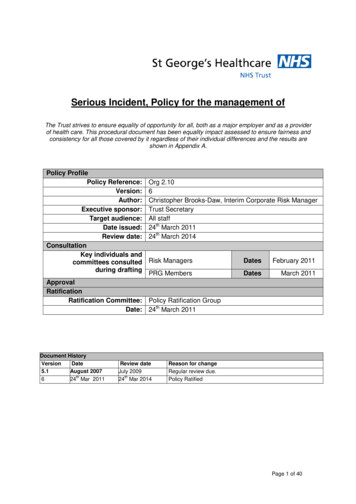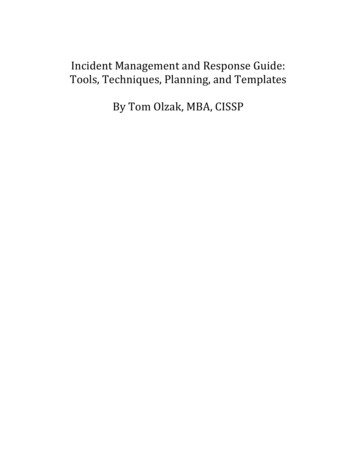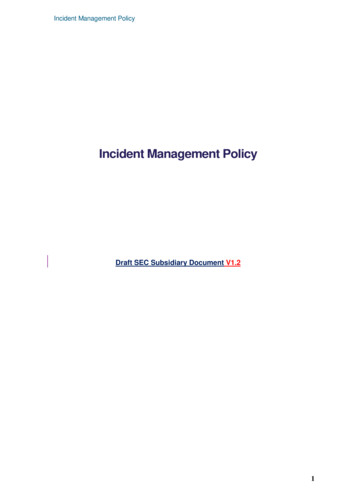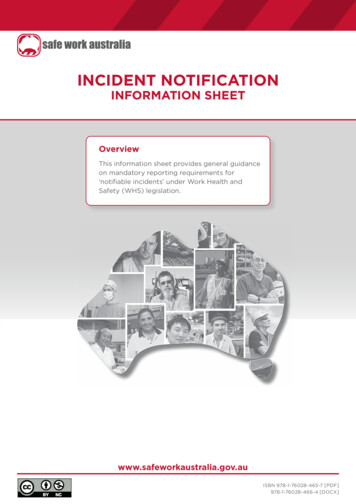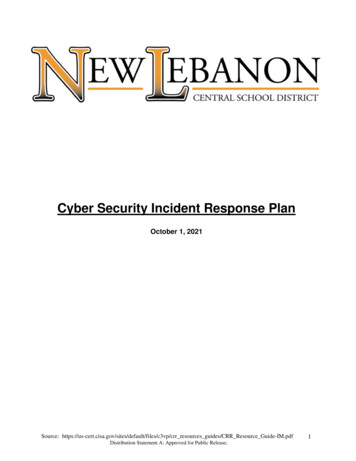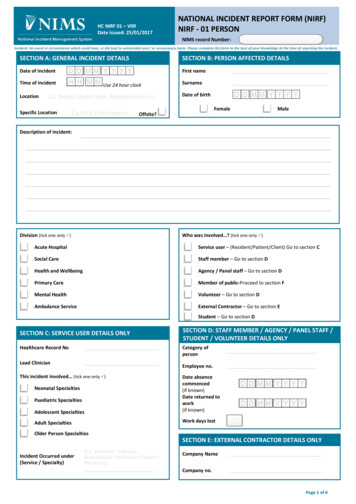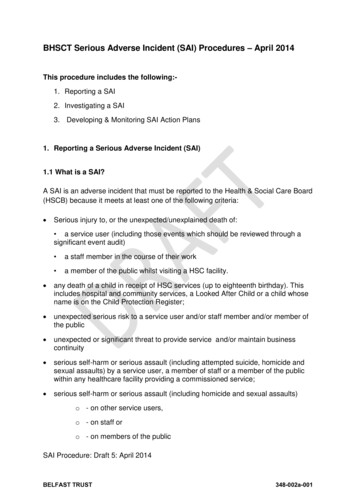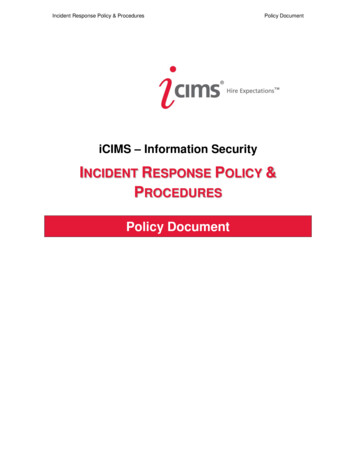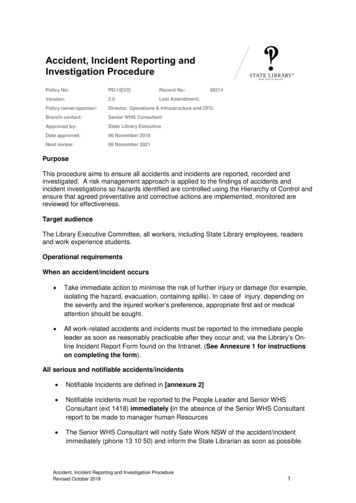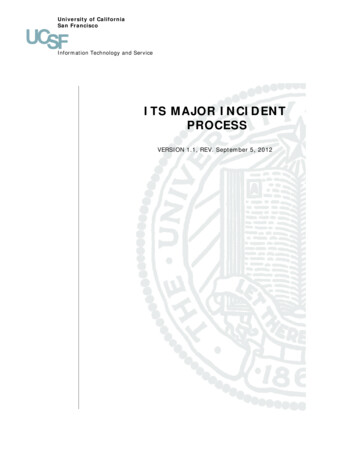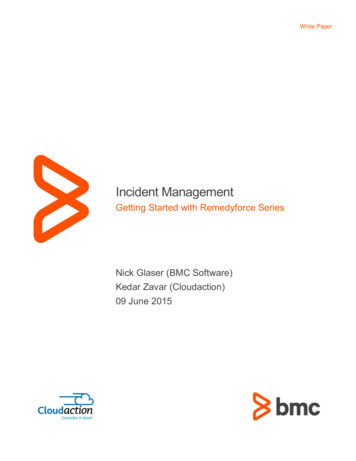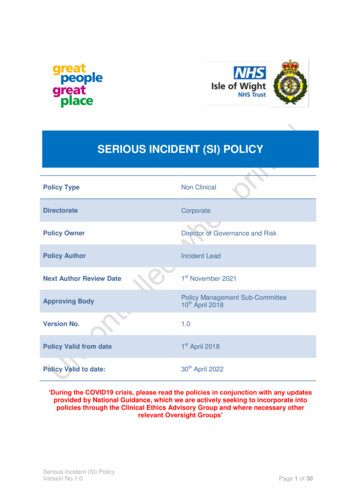
Transcription
SERIOUS INCIDENT (SI) POLICYPolicy TypeNon ClinicalDirectorateCorporatePolicy OwnerDirector of Governance and RiskPolicy AuthorIncident LeadNext Author Review Date1st November 2021Approving BodyPolicy Management Sub-Committee10th April 2018Version No.1.0Policy Valid from date1st April 2018Policy Valid to date:30th April 2022‘During the COVID19 crisis, please read the policies in conjunction with any updatesprovided by National Guidance, which we are actively seeking to incorporate intopolicies through the Clinical Ethics Advisory Group and where necessary otherrelevant Oversight Groups’Serious Incident (SI) PolicyVersion No.1.0Page 1 of 30
DOCUMENT HISTORY(Procedural document version numbering convention will follow the following format. Whole numbers for approvedversions, e.g. 1.0, 2.0, 3.0 etc. With decimals being used to represent the current working draft version, e.g. 1.1, 1.2,1.3, 1.4 etc. For example, when writing a procedural document for the first time – the initial draft will be version 0.1)Date ofIssueVersionNo.05.03.18DateApprovedDirector Responsiblefor ChangeNature of Change0.1Director of Quality19.03.180.1Director of QualityFirst Presentationof PolicyRatified at28.03.180.2Director of Quality10.04.181.010.04.18Director of Quality29.01.211.010.04.18Director of Governance& Risk21.05.211.010.04.18Director of Governance& RiskAddition to 1.0 TrainingApproved at12 month blanketpolicy extensiondue to covid 19applied with authorreview date set 6months prior toValid to Date.Extended policyuploaded andlinked back withnew cover sheetRatification /ApprovalPatient Safety SubCommitteePolicy ManagementSub-CommitteeQuality &PerformanceCommitteeCorporateGovernanceNB This policy relates to the Isle of Wight NHS Trust hereafter referred to as the TrustSerious Incident (SI) PolicyVersion No.1.0Page 2 of 30
Contents1Executive Summary . 42Introduction . 43Definitions . 44Scope . 75Purpose . 86Roles and Responsibilities . 86.1 Role of the Executive Team . 86.2 Role of the Director of Nursing . 86.3 Role of the Director of Quality Governance . 96.4 Role of Deputy Director of Quality. 96.5 Role of Head of Patient Safety and Compliance . 96.6 Role of Heads of Nursing & Quality (Clinical Business Units) . 96.7 Role of Investigation Lead . 106.8 Role of Investigation Team . 106.9 Role of Specialist Advisers . 116.10 Role of All Staff . 116.11 Role of the Patient Safety Sub-Committee. 117Policy Detail/Course of Action . 128Consultation . 189Training . 1810 Monitoring, Compliance and Effectiveness . 1811 Principles of the Serious Incident Framework . 1912 References. 2413 Appendices . 25Serious Incident (SI) PolicyVersion No.1.0Page 3 of 30
1Executive Summary1.1 This policy has been formulated to ensure staff respond to Serious Incidents to asatisfactory standard and comply with the requirements contained within NHSEngland Serious Incident Framework published on 27 March 2015. The Trust willalso follow guidance issued by the Care Quality Commission and NationalPatient Safety Agency and act in accordance with the NHS Constitution (27 July2015).1.2The Trust recognises the Serious Incident Policy as being a valuable tool forimproving the quality of health services it provides. We need to ensure that werespond appropriately when things go wrong as this is a key part of the way thatthe NHS can continually improve the safety of the services we provide to ourpatients.1.3We know that healthcare systems and processes can have weaknesses that canlead to errors occurring and, tragically, these errors sometimes have seriousconsequences for our patients, staff, services users and/or the reputation of theorganisations involved themselves. It is therefore vital to continually strive toreduce the occurrence of avoidable harm.2Introduction2.1 This supersedes the Serious Incident Requiring Investigation guidance previouslyin use. Following a review commissioned by the Trust in 2017, it wasrecommended that the Trust should adhere to a Serious Incident Policy, whichdirectly aligns to NHS England’s SI Framework 20153DefinitionsCQCGMCNPSANRLSSICare Quality CommissioningGeneral Medical CouncilNational Patient Safety AlertNational Reporting and Learning SystemSerious Incident (in line with SI Framework 2015)Serious Incident(previously known as a SIRI; serious incident requiringinvestigation). In broad terms, serious incidents are events inhealth care where the potential for learning is so great, or theconsequences to patients, families and carers, staff ororganisations are so significant, that they warrant using additionalresources to mount a comprehensive response. Serious incidentscan extend beyond incidents which affect patients directly andinclude incidents which may indirectly impact patient safety or anorganisation’s ability to deliver on-going healthcare. A full definitionis included in the NHS England Serious Incident Frameworkpublished on 27 March 2015.Serious Incident (SI) PolicyVersion No.1.0Page 4 of 30
Level 1(concise) - suited to less complex incidents which can bemanaged by individuals or a small group of individuals at a locallevel.Level 2(comprehensive) - suited to complex issues which should bemanaged by a multidisciplinary team involving experts and/orspecialist investigators.Level 3(independent) investigations suited to incidents where the integrityof the internal investigation is likely to be challenged or where itwill be difficult for an organisation to conduct an objectiveinvestigation internally due to the size of organisation, or thecapacity/ capability of the available individuals and/or number oforganisations involved.IncidentAn incident may be defined as ‘any event that has given rise toactual or possible harm such as injury, patient dissatisfaction,property loss or damage’. Examples of this are a patient or a staffinjury; distress or death due to clinical error; non- compliance withTrust policy incidents where equality discrimination has occurred;a theft or fraud; a health and safety injury.Harm(actual rather than potential) - Moderate harm: Any patient safetyincident that resulted in a moderate increase in treatment (e.g. thelength of a hospital stay increased by four to 15 days) and whichcaused significant but not permanent harm to persons receivingNHS-funded care. Moderate increases in treatment may mean anunplanned return to surgery, an unplanned re-admission, aprolonged episode of care, extra time in hospital or as anoutpatient, cancelling of treatment, or transfer to another treatmentarea (such as intensive care).Serious harm (as defined in the NHS England Serious IncidentFramework): Severe harm (patient safety incident that appears to haveresulted in permanent harm to one or more persons receivingNHS-funded care);Chronic pain (continuous, long-term pain of more than 12weeks or after the time that healing would have been thoughtto have occurred in pain after trauma or surgery ); orPsychological harm, impairment to sensory, motor orintellectual function or impairment to normal working orpersonal life which is not likely to be temporary (i.e. has lasted,or is likely to last for a continuous period of at least 28 days).Prolonged psychological harm: Psychological harm which aservice user has experienced, or is likely to experience, for acontinuous period of at least 28 days.Serious Incident (SI) PolicyVersion No.1.0Page 5 of 30
DatixThe DATIX system is a risk management system used by theTrust to record information on the following modules: Never EventIncidentsRisksComplaintsPatient Advice and Liaison ServiceComplimentsClaimsInquestsThese are a subset of serious incidents that meet all the followingcriteria: They are wholly preventable, where guidance or safetyrecommendations that provide strong systemic protectivebarriers are available at a national level, and should havebeen implemented by all healthcare providers.Each Never Event type has the potential to cause seriouspatient harm or death. However, serious harm or death isnot required to have happened as a result of a specificincident occurrence for that incident to be categorised as aNever Event.There is evidence that the category of Never Event hasoccurred in the past, for example through reports to theNational Reporting and Learning System (NRLS), and a riskof recurrence remains.Occurrence of the Never Event is easily recognised andclearly defined – this requirement helps minimise disputesaround classification, and ensures focus on learning andimproving patient safety. Full details and definitions areavailable in the NHS England revised Never Events Policyand Framework; re-revised January 2018 (supersedesframework of 2015) using the following ents-policy-andframework/STEISThe Strategic Executive Information System (STEIS) developed bythe Department of Health and used to report serious incidents andmanage them to completion.Decision TreeAn on-line tool devised by the National Patient Safety Agency(NPSA) to help support fair and consistent staff treatment withinand between healthcare organisations. The link to the hs.uk/resources/?EntryId45 59900Serious Incident (SI) PolicyVersion No.1.0Page 6 of 30
RCARoot cause analysis is a structured investigation following NationalPatient Safety Agency (NPSA) guidance that aims to identify thetrue cause of a problem and identify learning and the actionsnecessary to either eliminate or significantly reduce risk. RCA isthe process used for undertaking systems-based investigationsthat explore the problem (what?), the contributing factors to suchproblems (how?) and the root cause(s)/fundamental issues (why?)CandourAny patient harmed by the provision of healthcare services isinformed of the fact and an appropriate remedy offered, regardlessof whether a complaint has been made or a question asked.Root CauseAny action/inaction that, because it occurred meant that theincident was, on the balance of probabilities, bound to occur.Contributory Factor Any action/inaction that increased the likelihood of the incidenthappening, but did not make it certain that it would occur.Lessons Learnt4Actions or inactions identified during the course of an investigationthat had no bearing on the likelihood of the incident occurring, butdid not comply with policies, procedures or otherwise recognisedbest practice.Scope4.1 This policy applies to all healthcare staff employed by the Trust. Independentcontractors providing services for NHS Isle of Wight are also encouraged toadopt this policy or to develop similar procedures also based on the NationalReporting and Learning System (NRLS) guidance.4.2 Implementation of this policy will ensure that:4.2.14.2.24.2.34.2.44.2.54.2.64.2.7The response to serious incidents is appropriate and timely.There is early, meaningful and sensitive engagement with affectedpatients and/or their families/carers, from the point at which a seriousincident is identified.Serious incidents are reported in a timely fashion and there is appropriateand proportionate liaison with the IW Clinical Commissioning Group.Incidents are managed and investigated in the most effective way,minimising risks to patients, their families, carers and staff.The investigation and analysis of incidents follow a consistent, systemsbased approach and focus on identification of learning to inform changesto practice and procedures to eliminate or minimise associated risks.There are mechanisms in place to ensure that actions from action plansare SMART (specific, measurable, attainable, relevant, time-bound),monitored until implemented, and there is demonstrable evidence thatthe action plan has resulted in the anticipated practice or systemimprovement.Quality assurance processes are in place to ensure completion of highSerious Incident (SI) PolicyVersion No.1.0Page 7 of 30
4.2.8quality investigation reports and action plans to enable timely learningand to prevent or minimise the risk of recurrence.There are mechanisms and effective communication channels to facilitatethe sharing of lessons learned across the organisation and more widelywhere required.4.3 This policy does not over-ride existing lines of accountability nor does it replacethe duty to inform the police and/ or other organisations or agencies whereappropriate.5Purpose5.1 This policy is intended to ensure the Trust is managing serious incidentinvestigations effectively and delivering meaningful learning to support the qualityand safety of patient care and patient experience.5.2 This document supports the SI process whilst ensuring that the Trust responds toand manages serious incidents appropriately, and meets nationally recognisedbest practice for the investigation and analysis of incidents.5.3 The policy applies to all Trust staff directly and indirectly employed within theTrust and has been designed to ensure that staff know how to respond to aserious incident, how the investigations process is managed, and understandtheir responsibility and role if involved in an investigation.66.1Roles and ResponsibilitiesRole of the Executive TeamThe role of the Trust’s Executives is to ensure:6.1.1 A robust escalation process of serious/high risk incidents is in place, from theClinical Business Units through to the Executive team.6.1.2 Commitment to act as Chairperson for all Level 2 or 3 serious incidentintegrated panel review meetings.6.1.3 There is representation by Execs at the twice-weekly incident review meetings.6.1.4 That any requests for “downgrading” a serious incident are reviewed,challenged where appropriate and formal confirmation of agreement given, priorto requesting the same from the IW Clinical Commissioning Group via theCorporate Patient Safety Team.6.2 Role of the Director of NursingThe Director of Nursing is the Executive lead for Patient Safety.Serious Incident (SI) PolicyVersion No.1.0Page 8 of 30
6.3 Role of the Director of Quality GovernanceThe Director of Quality Governance is responsible for:6.3.16.3.26.3.3Ensuring that the Trust’s incident reporting and management processesare robust and effective.Providing information and updates on serious incidents that haveoccurred, to external agencies, as appropriate, such as NHSI and CQC.Ensuring that non-compliance with this policy is addressed withindividuals and teams as appropriate.6.4 Role of Deputy Director of QualityThe Deputy Director of Quality is responsible for:6.4.16.4.26.4.36.4.46.4.5Ensuring that systems are in place to identify and learn from clinical andnon-clinical incidents and near misses;Ensuring that the correct incidents are investigated in terms of learningand contributing to the quality and safety agenda; and in line with nationalrequirements;Supporting development of a culture of learning from mistakes andadopting best practice and ensuring this is promoted through seriousincident investigations;Providing advice and support to the Investigation Lead/team;Ensuring arrangements are in place to report serious incidents on to thenational database (STEIS).6.5 Role of Head of Patient Safety and ComplianceThe Head of Patient Safety is responsible for:6.5.16.5.2Ensuring that the correct incidents are investigated in terms of learningand contributing to the quality and safety agenda; and in line with nationalrequirements;Supporting development of a culture of learning from mistakes andadopting best practice and ensuring this is promoted through seriousincident investigations.6.6 Role of Heads of Nursing & Quality (Clinical Business Units)The Heads of Nursing & Quality are responsible for:6.6.16.6.2With the responsible clinician, contacting patient and/or their family, asappropriate, to explain the findings of the initial incident, offering anapology and offering the opportunity to input during the investigation(Duty of Candour).Ensuring that the investigation lead and nominated team are supportedduring the investigation, providing resources where possible, socompletion of the investigation can be undertaken within agreedSerious Incident (SI) PolicyVersion No.1.0Page 9 of 30
6.6.36.6.46.6.56.6.66.6.76.6.8timeframes;Issuing Terms of Reference to the investigation lead (see link under 7.6)Supporting development of a culture of learning from mistakes andadopting best practice and ensuring this is promoted through seriousincident investigations.Developing a SMART action plan before the draft report is finalized fromthe recommendations identified by the investigation team;Monitoring completion of action plans from incident investigations; thesewill be performance monitored and will be added to the Datix system as away of monitoring completed actions and as a tool for auditing agreedactions, via the Corporate Patient Safety p://intranet.iow.nhs.uk/SI) are fully completed and submitted forclosure following the Integrated Panel Review (IPR) meeting.With the responsible clinician, sharing final investigation reports andfindings with the patient and/or their family as appropriate.6.7 Role of Investigation LeadThe Investigation Lead for serious incident investigations is responsible ng the incident which they have been nominated toinvestigate;Supporting the Investigation team throughout the investigation,unblocking barriers to engagement in the process and timely completion;Ensuring that the incident is fully investigated and the methodologiesused are appropriate to maximise learning;Chairing the initial and (where appropriate) second table top reviewmeeting(s) and receiving all evidence and statements gathered from theinvestigation team;Writing a draft investigation report ensuring it is clear, comprehensive,and that the recommendations are proportionate and appropriate todeliver changes that will reduce the risk of a similar event occurring;Sharing the draft report with relevant team(s) and subject specialistsMeeting deadlines for completion of the investigation to ensure statutorytimescales are met for submission of the final draft report, and later thefinal SI report, to the Isle of Wight Clinical Commissioning Group, andescalating to the Patient Safety Lead when the timescales look likely tobe compromised.6.8 Role of Investigation TeamThe Investigation team (nominated) for serious incident investigations areresponsible for:6.8.16.8.26.8.3Understanding the incident which they have been nominated to assist ininvestigating;Using methodologies appropriate to the incident to maximise learning;Ensuring that delegated tasks are completed in a timely way and asinstructed by the investigation lead, to help ensure that the leadSerious Incident (SI) PolicyVersion No.1.0Page 10 of 30
investigator can adhere to and meet statutory timescales for submissionof the final draft report.6.9 Role of Specialist AdvisersThe investigation team may call upon the expertise of specialist advisers (e.g.clinicians in gynaecology, orthopaedics, anaesthetics, infection control or tissueviability) to help during the investigation process to gain specialist knowledge andunderstanding.Other specialist advisers may include but are not restricted n leadFire and security advisorLocal security management specialistHealth and safety leadHead of information governanceSafeguarding adults leadNamed nurse/doctor for safeguarding children and young people6.10 Role of All StaffAll staff are responsible for:6.10.1 Ensuring that immediate action is taken to prevent further harm or arepeat incident;6.10.2 Escalating potential serious incidents to their line manager at the time ofthe incident;6.10.3 Reporting all incidents as soon as possible;6.10.4 Complying with this policy;6.10.5 Supporting an open culture towards incidents and investigations andsupporting the investigation process appropriately; and6.10.6 Actively working towards sharing and embedding the learning identifiedfrom incidents and investigations.6.11 Role of the Patient Safety Sub-CommitteeThe Patient Safety sub-committee is responsible for:6.11.1 Receiving serious incident investigation reports and ensuring they havesufficient assurance that a robust investigation has been carried out andthat any supporting recommendations/action plan will address the rootcause of the incident and mitigate the identified risks.6.11.2 Receiving monthly or quarterly serious incident investigation reportsidentifying trends and themes and changes in working practice.6.11.3 Promoting and enabling sharing of lessons learned and delivery of Trustpatient safety priorities.Serious Incident (SI) PolicyVersion No.1.0Page 11 of 30
7Policy Detail/Course of Action7.1 Procedural Document Detail / Course of ActionTo implement the SI policy successfully, the Trust needs to ensure it has aculture of being open and honest; a mechanism to report incidents of concern;support for both patients and staff involved.In a service as large and complex as the NHS, things will sometimes go wrongand sometimes users will not be satisfied with their level of care. When thishappens, the response should not be one of blame and retribution, but oflearning and a drive to reduce risk and improve the service for future patients,visitors and staff.When a serious event or incident occurs we need to ensure there are systematicmeasures in place for safeguarding patients, staff, property, NHS resources andthe reputation of the organisation and wider NHS. This includes the responsibilityto learn from these incidents to improve the quality and safety of patient care andminimise the risk of them happening again.A robust approach to investigation, analysis, and learning from incidents isrequired in order to identify how something happened and whatrecommendations/solutions should be put into place to avoid future recurrence.There are no exceptions to the Trust's commitment to reporting and learning fromincidents and it is therefore expected that all staff will comply with this policy. Inaddition, there is an understanding by the Trust that learning requires open,honest and timely reporting. This will be achieved within an open and fair culturein which no disciplinary action will result from reporting incidents (includingserious incidents) unless the incident is malicious, negligent and/or criminal, i.e.where one or more of the following applies: The incident has resulted in a police investigation that results in a prosecution; There are repeated occurrences involving the same individual; or In the view of the Trust and/ or any professional body, the action causing theincident was far removed from acceptable practice, constituting grossmisconduct.Investigations are conducted for the purposes of learning to support delivery ofsafe, high quality care and prevent recurrence. They are not conducted to holdany individual to account. Other processes exist for that purpose includingcriminal proceedings, disciplinary procedures, employment law and systems ofservice and professional regulation, such as the Care Quality Commission andthe Nursing and Midwifery Council (NMC), the Health and Care ProfessionsCouncil (HPC), and the General Medical Council (GMC).This organisation advocates justifiable accountability and a zero tolerance forinappropriate blame. The Incident Decision Tree should be used to promote fairand consistent staff treatment within the context of this policy.Serious Incident (SI) PolicyVersion No.1.0Page 12 of 30
7.2 Immediate Response To Serious IncidentsThe immediate response to an incident will depend on its severity. In allinstances, the first priority is to ensure the needs of individuals affected by theincident are attended to, including any urgent clinical care which may reduce theharmful impact. Staff Take immediate action to manage the incident and prevent further harm,e.g. make area safe, quarantine affected equipment, remove patient /staff member from harm, isolate hazard.Ensure appropriate medical assessment and treatment is provided asnecessary.Ensure all concerned are safe and supported.In the event of an incident involving a machine or equipment, the devicemust be taken out of service immediately, retained for inspection andclearly identified with a label. The equipment should be left exactly as itwas at the time of the incident and no adjustments or intervention mustbe made unless required for safety reasons. Details of the equipmentinvolved must be recorded on the incident form, including the bar codewhere relevant.Retain any relevant evidence related to the incident that may be requiredfor further investigation (e.g. medication packaging).Copy and secure all relevant documentation to preserve evidence tofacilitate any investigation and maximise learning.Make a decision about the seriousness of the incident and whether theyneed to inform their senior manager and lead professional.Seek extra help or specialist support if required.Ensure an incident report is completed, with further statements of fact ifnecessary, as soon after the event as possible and within 24 hours.7.3 Serious Incidents Requiring Immediate EscalationIn the case of a serious incident that requires immediate escalation, e.g.unexpected death or major outbreak of a serious infectious disease; it should bereported immediately, irrespective of the time of day, to the Senior Manager andExecutive Director on-call.Appropriate remedial action should be taken for all incidents as soon as possibleafter the incident has occurred regardless of whether the incident is subsequentlyescalated for investigation or not.7.3.1The Incident Escalation ProcessA key part of incident management is investigation. All incidents shouldbe investigated to learn lessons and take remedial action. However, theinvestigation should be proportionate to the scale or complexity of theincident or near miss and the likelihood of it recurring. The majority ofincidents can be followed-up locally by the manager reviewing theincident. Local action may be taken before the incident is closed by thereviewing manager. The relevant incident report on Datix should alwaysSerious Incident (SI) PolicyVersion No.1.0Page 13 of 30
be updated as appropriate to provide a complete record of all reviewingand investigation activity for that incident. Expected timescales for thereview and closure of incidents on Datix are outlined in the IncidentManagement Policy.7.3.2Identifying Events That Require InvestigationEvents or incidents that require investigation to ensure that theorganisation is learning and improving are not always recorded on theDatix Incident module. They may be identified through other routes suchas notification of an inquest or legal claim; through information receivedfrom a formal complaint; or via an enquiry and request to investigatereceived from the CCG. Where no incident has been recorded, themember of staff who has identified the concerns should complete anincident report on Datix with a request that the incident is reviewed forescalation to an investigation.7.3.3Review of IncidentsAll incidents reported via the electronic incident reporting system arereviewed by the Datix and Incident Team, the responsible manager forthe incident, and if appropriate a specialist adviser (e.g. Tissue ViabilityService; Information Governance etc.,) and the Patient Safety Team asrecorded in the Incident Management Policy.Any incident that the Datix and Incident Team review that may be apotential serious incident is forwarded to the Executive Director ofNursing and the Deputy Director Quality (or their designated deputy) forreview. If the incident is considered by both reviewers to meet thedefinit
Serious Incident (SI) Policy Version No.1.0 Page 1 of 30 SERIOUS INCIDENT (SI) POLICY Policy Type Non Clinical Directorate Corporate Policy Owner Director of Governance and Risk Policy Author Incident Lead Next Author Review Date 1st November 2021 Approving Body Policy Management Sub-Committee 10th April 2018 Version No. 1.0
